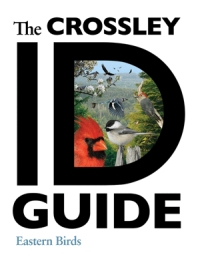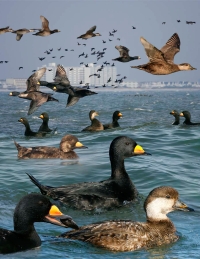The Crossley ID Guide

On first opening the book, you're hit by a multitude of plates packed with an almost overwhelming number of photographs; it takes a minute before you can really start to look in any depth at what the book is offering. A full page is devoted to most species, with some rare or more local species taking half or quarter of a page. A scenic photograph showing typical habitat for each species forms the backdrop for the plates, on top of which are overlaid a large number of photos of the species itself. In the foreground of the plate, labelled images of the main plumages are shown; moving further back into the plate, a selection of images showing the same plumages in a variety of poses and displaying different behaviours are shown. The vast majority of these images are photoshopped onto the background scene, and here is one of my first quibbles with the book. For species where the habitat is typically open and lacking any distance reference points — seabirds, for example — this works well; for species depicted in other habitats, though, this 'cut out and stuck on' effect severely distorts your sense of perception and takes away from one of the book's goals of displaying lifelike scenes.

Perhaps part of my reluctance to warm to this book is down to the fact I can't quite work out how to use it. It's worth remembering it is definitely not a field guide, not least due to its weight and dimensions. It won't help you identify tricky species with feather-by-feather detail, either. But it does give you a feel for most of the species in an almost subconscious way. Maybe, in that way, this book is better suited to beginners than it is to more experienced birders wishing to further their knowledge of tricky identifications; and the language used in the text certainly wouldn't detract from that, either.
Has The Crossley ID Guide changed my view on photographic guides? Sadly, no. I think it's definitely a bold and thought-provoking move, possibly even in right direction, but I'm afraid, for me at least, it doesn't make the grade. That said, a lot of work has clearly gone into this book and, with an RRP of only £24.95, it will hardly break the bank. I'm quite sure opinion will be split on The Crossley ID Guide and there will be those who'll enjoy browsing through this book, even if I'm not one of them.
544 pages
ISBN: 978-0-691-14778-9
Published by Princeton University Press (2011)


